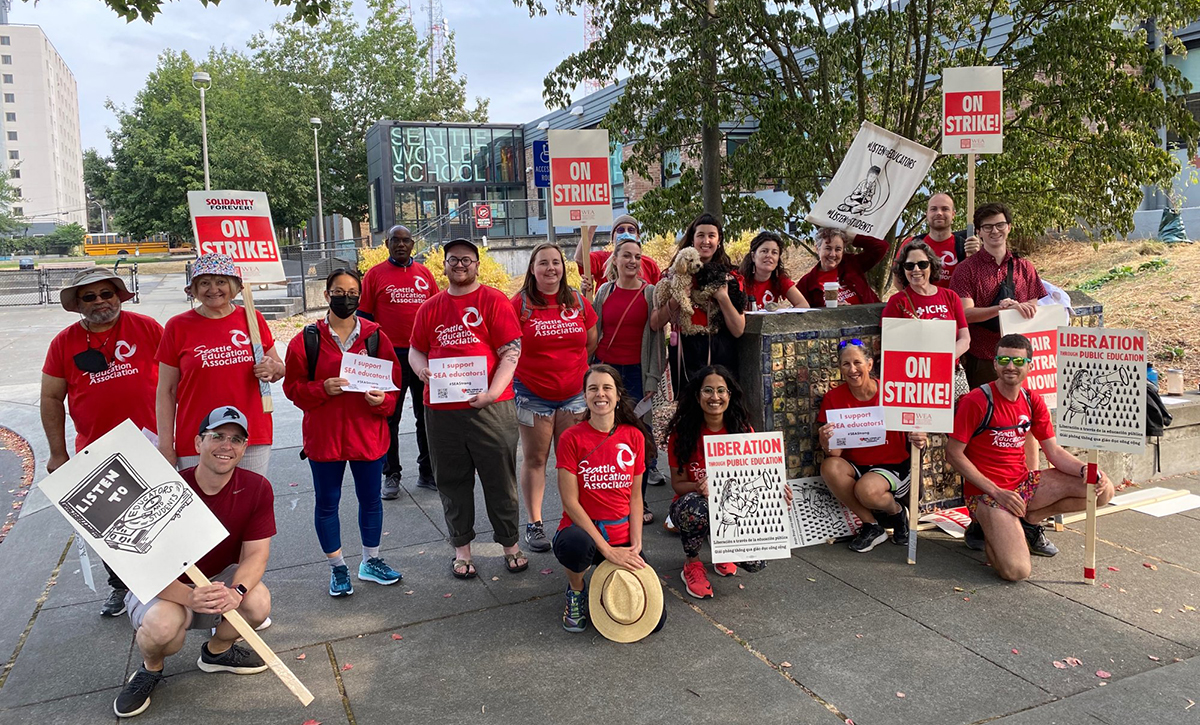Seattle Teachers End Strike, Aiming for More Employees for Fewer Students
There are roughly the same number of people in Seattle’s schools today as in 2013-14. But there are 1,725 fewer students and 1,711 more employees

Get stories like this delivered straight to your inbox. Sign up for The 74 Newsletter
The Seattle Education Association reached a tentative agreement with the Seattle Public Schools after a week-long strike. The union represents some 6,000 public school teachers and support employees.
“This was an incredible effort by the … bargaining teams. We want to thank everyone on both teams who worked hard to come to a resolution,” read a statement from the district.
“Our solidarity on the picket lines and the enormous community support we received made all the difference,” read the union’s statement.
If comments on the union’s Facebook page are any indication, members are upset that they were asked to vote to suspend the strike without seeing the full tentative agreement. The Seattle union used the same process when it ended its strike in 2015, and there were similar complaints.
The vote results highlighted member frustration. After hours of debate, only 57% voted to suspend the walkout and return to work. But that was enough. Schools reopened Sept. 14.
Union members may be upset about a lack of transparency, but the citizens of Seattle, who have to pay for whatever provisions have been negotiated, have yet to hear a single word about the contract’s contents. Such secrecy after an agreement is reached is unwarranted.
The union deemphasized its salary demands in public statements, saying it wanted “respectful pay.” It claimed the sticking points concerned inadequate staffing for the English learners and special education students the district seeks to place in mainstream classrooms.
Seattle Public Schools spends nearly 85 cents of every dollar it receives on employee wages and benefits. Pay ranges from a minimum of $63,180 to a maximum of $123,506. The average salary for a Seattle public school teacher was reportedly $88,897 in 2020-21.
The legislature allocated a 5.5% inflation pay hike for K-12 employees statewide, and the district offered an additional 1% on top of that.
That all sounds pretty respectful, but teachers in nearby Kent just settled their eight-day strike with an 8% raise, so I suspect that’s what the Seattle union aimed for.
As for staffing, Marguerite Roza of Edunomics Lab tweeted this graph of Seattle’s enrollment and staffing since 2013-14:
There are roughly the same number of human beings roaming the halls of Seattle’s schools today as there were in 2013-14. The difference is there are 1,725 fewer students and 1,711 more employees.
Edunomics Lab also reports that the district budgeted for 501 more full-time equivalent teachers’ aides for next year, which more than doubles the increase from the previous eight years combined.
The Seattle union set up its understaffing message months in advance, releasing a member survey indicating that one-third of the city’s school employees plan to leave the district in the next five years.
This might sound alarming, until you check to see what percentage of school employees left over the previous five-year period. It was 40%. So losing one-third in the next five years would actually be a marked improvement in retention.
These details probably won’t figure into the settlement, however. The union boasted of the positive coverage it received and even used paid advertising for its positions.
At least one member of the school board laid the blame for the impasse on the legislature. “We can’t squeeze the water that we need to live out of the rocks they’ve given us,” said Lisa Rivera-Smith.
State law requires 180 days of instruction, so the strike days will be made up one way or another. But for students who have already missed almost two years of classroom time, the strike put them even further behind.
Mike Antonucci’s Union Report appears most Wednesdays; see the full archive.
Get stories like these delivered straight to your inbox. Sign up for The 74 Newsletter

;)